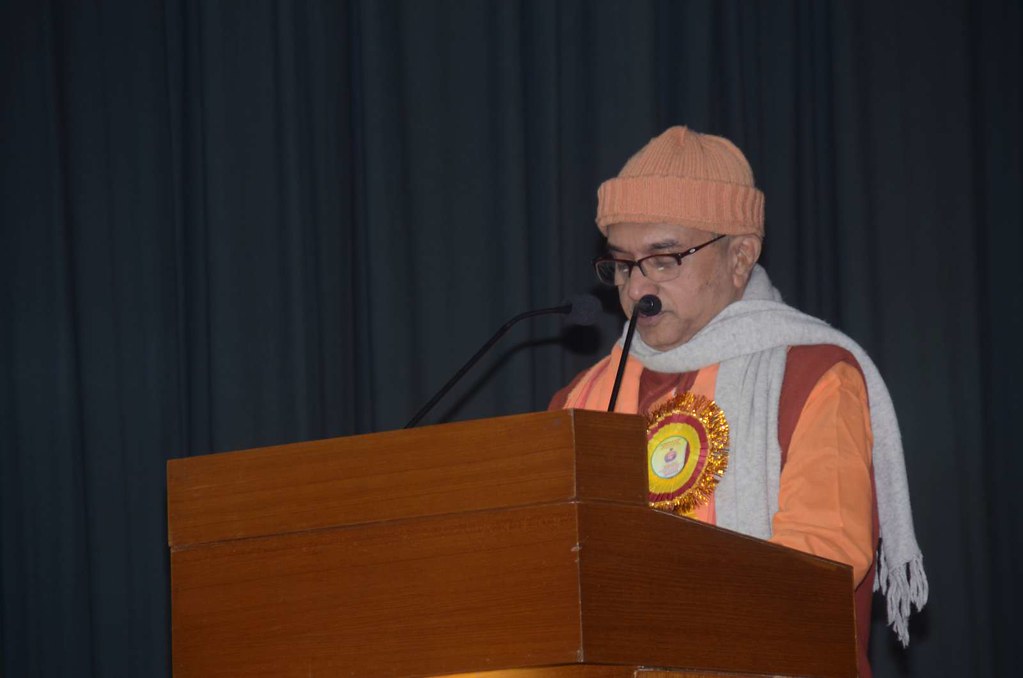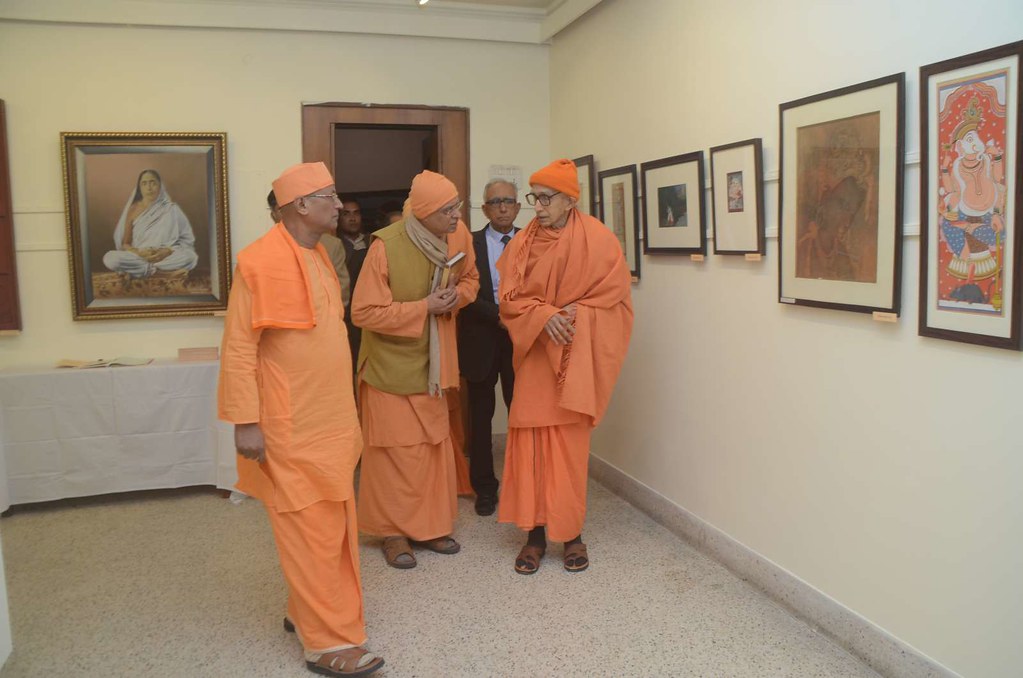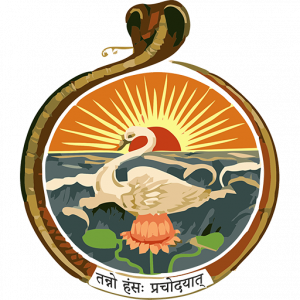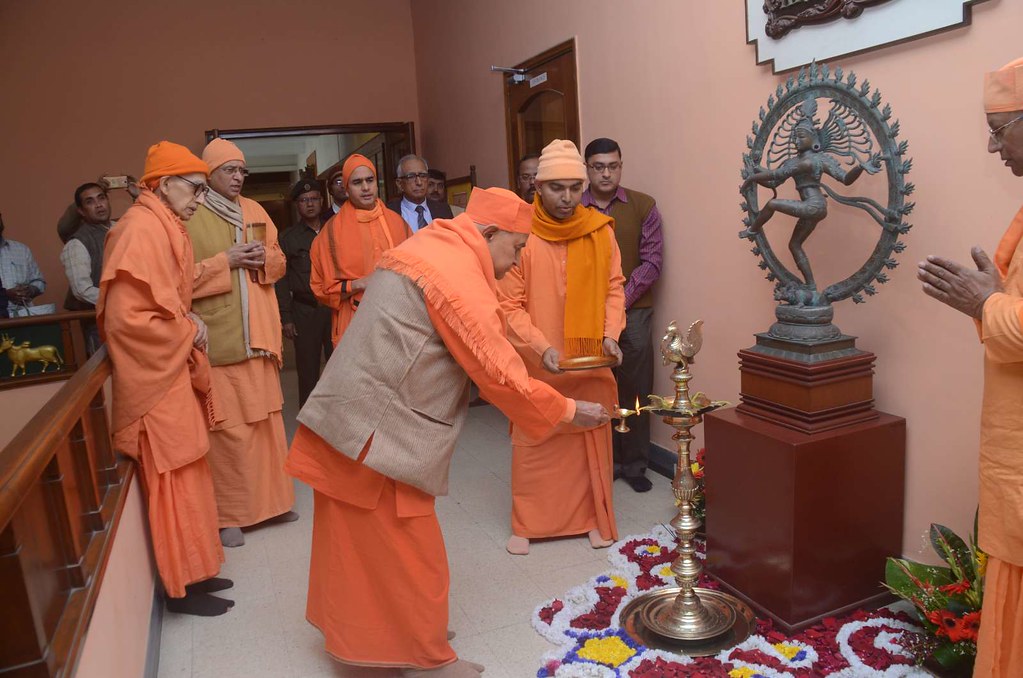The Centre for Indological Studies and Research organized a National Seminar on Indian Culture and Philosophy and an Exhibition on Indian Art to commemorate the 150th Birth Anniversary of Swami Abhedananda on 17 and 18 January 2018 as per the directive of the Headquarters. The Exhibition was inaugurated by Revered Swami Gautamanandaji Maharaj, Vice-President, Ramakrishna Math & Ramakrishna Mission, Belur Math, by lighting the Lamp in the Art Gallery of the Institute. The Seminar was inaugurated on the same day at 03-00 PM in the Vivekananda Hall. After the Vedic chanting by the Monks of the Institute and Felicitation of the Speakers, Swami Suparnanandaji, Secretary of the Institute delivered the Welcome Speech. A short sketch of Swami Abhedanandaji’s Life and Mission and benediction was given by Revered Swami Gautamanandaji Maharaj. Swami Bhajananandaj, Senior Trustee & Governing Body Member, Ramakrishna Math and Ramakrishna Mission delivered the Key Note Address. Swami Suviranandaji Maharaj, General Secretary, Ramakrishna Math & Ramakrishna Mission, Belur Math, gave the Chairman’s Speech. The Vote of Thanks was proposed by Prof. Radharaman Chakraborty, Director, UNESCO Programme on IUHU.
Four Academic Sessions were held on 17 and 18 January 2018 in the Vivekananda Hall and Shivananda Hall. In the First Academic Session Swami Paramatmanandaji, General Secretary, Sri Ramakrishna Vedanta Math, Kolkata, spoke on “Swami Abhedananda’s life & Philosophy”.

Dr. U R Nagaswamy, Art Historian & Epigraphist, Former Vice Chancellor, Kanchipuram University, former Director, Archeology Deptt. T.N., delivered the lecture on “Bases of Indian Culture”. Prof. Prabal Kumar Sen, Formerely Head, Deptt. of Philosophy, University of Calcutta, delivered the lecture on “An Overview of Indian Philosophical Systems”. The Coordinator of this Academic Session was Prof. Ranjana Roy, Former Professor, University of Calcutta. In the Second Academic Session, Swami Nityasthanandaji, Ramakrishna Ashrama, Mysore, spoke on “Indian Culture through Ages”. Prof. Durga Basu, Former Head, Archeology Deptt., University of Calcutta, gave a Power Point presentation on “Indian Sculpture and Architecture–Aesthetics & Spirituality”. The Coordinator of the Second Academic Session was Dr. U R Nagaswamy. In the Third Academic Session Dr. Anjali Capila, Retd. Professor, University of Delhi, V.P. of Mountain India Peoples Forum, gave a power point presentation on “Folklore of the Himalayan Communities: Our Intangible Heritage”. There was a slight change in the programme; and next Dr. Kumud Kanitkar, Art Historian, Asiatic Society, Mumbai, delivered the talk on the subject “Medieval Temple Sculptures–umarkers of social History”. The Coordinator of the Third Academic Session was Prof. Prabal Kumar Sen. In the Fourth Academic Session, Prof. Joy Sen, IIT, Kharagpur, gave a Power Point Presentation on “The Logical and Analytical Aspects of Indian Culture”. After that Prof. Samiran Chandra Chakraborty, former Director, School of Vedic Studies, gave a talk, “Spirituality in Indian Culture and Philosophy”. The Coordinator of this Session was Prof. Sati Chatterjee, Former Head, Deptt. of English, Jadavpur University.
The Moderator of the Panel Discussion was Prof. Krishna Roy, Former Head, Deptt. of Philosophy, Jadavpur University. Prof Sati Chatterjee spoke on “The Modality of Projecting the Indian Profile in the West today”. Sri Arun Ghose, Art Critic, Ex-Curator, Festive of India, Govt. of India, spoke on “Role of Art in Ramakrishna Movement”. The Speech of Prof. Ranjana Roy, Emeritus Professor of Deptt. of Anthropology, University of Calcutta, was on “Some Aspects of Intangible Cultural Heritage of India”. Prof. Jayaraman Suresh, Former Director, Gyanjyoti College, North Bengal University, spoke on “Nagapuja in India”. Prof. Swati Bhattacharya, Associate Professor, Govt. College of Art & Craft, Kolkata, spoke on “Fearful Symmetry: Representation of Kali in Indian Art.” Dr.Debashish Nayak, Director, Centre for Heritage Management, Ahmedabad University, gave a Power Point presentation on “Role of Community in Preserving and managing Historic Cities of India”.

Swami Balabhadranandaji Maharaj, Asstt. General Secretary, Ramakrishna Math & Ramakrishna Mission, Belur Math, delivered the Valedictory Address. Prof. Hemadri Chatterjee, Lecturer, Ramakrishna Mission Shilpapitha, Belgharia summed up the proceedings. The Vote of Thanks was proposed by Sri Sakti Prasad Mishra, Nivedita Chair, Centre for Indological Studies and Research of the Institute.

In addition to the Inaugural Session and Valedictory Session, there were four Academic Sessions with two talks in each Session. There was one more Session of Panel Discussion in which six Panelists presented short speeches on six different topics. Total number of Speakers who spoke during the Seminar were 24, Registered Delegate 176, Guest Observer 55, Total Participants 255. A total number of 45 office staff and supporting staff served during the Seminar leading the grand total to 300 persons. Refreshments and lunch were served to all those who attended the Seminar. In a bid to give shape to the abstract ideas and also to inculcate aesthetic sense among the public towards art, an Exhibition on Indian Art was organized side by side. A separate Report of the Art Exhibition is attached. As a whole, we could evoke interest of the general public and the academic circles towards Indian Culture and Philosophy.














